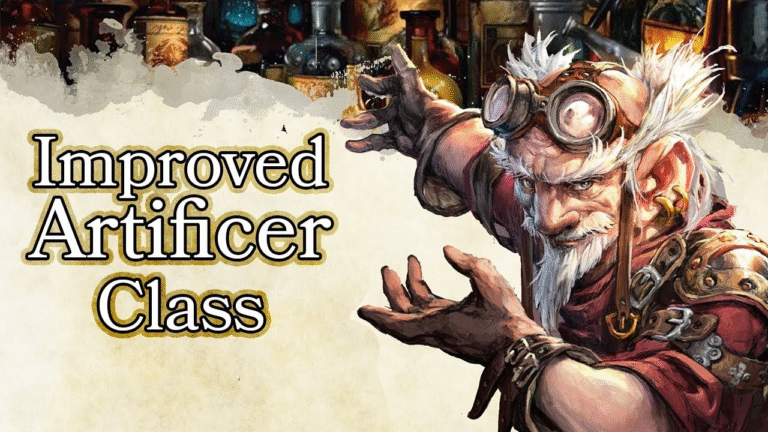In the world of Dungeons & Dragons 5e (Fifth Edition), few classes blend science, magic, and invention as seamlessly as the artificer 5e. Originally introduced in Eberron: Rising from the Last War, the Artificer is the ultimate magical tinkerer — part wizard, part inventor, and all genius.
With the ability to imbue mundane objects with arcane power, craft magical items, and support allies through creative engineering, the Artificer adds a unique flavor to any campaign.
What Is an Artificer in 5e?
The artificer 5eis a half-caster class (like the Paladin or Ranger), meaning they have a smaller spell pool than full casters like Wizards or Clerics. However, what they lack in raw spell power, they make up for with unmatched magical crafting, infusions, and mechanical innovation.
At their core, Artificers are inventors. They use intelligence (INT) as their primary stat and create magical tools and weapons that can shift the tide of battle. If you enjoy the idea of a steampunk alchemist, arcane engineer, or techno-mage, this is the class for you.
Artificer Class Features
Let’s dive into the core features of the artificer 5e class:
1. Spellcasting
Artificers use INT for their spellcasting ability and have access to a curated list of utility and support spells like Cure Wounds, Shield of Faith, Dispel Magic, and Fireball (depending on subclass). They prepare spells from their list daily, offering flexibility between adventures.
2. Magical Infusions
This standout feature allows Artificers to imbue non-magical objects with magical effects. You can turn a basic sword into a +1 weapon, or give your rogue buddy Boots of the Winding Path for teleportation. The best part? You can swap your known infusions as you level up.
3. Tool Expertise
At 6th level, Artificers become masters of their tools, doubling proficiency bonuses. Whether you’re disarming traps, brewing potions, or crafting alchemical gadgets, no one does it better.
4. The Right Tool for the Job
This utility feature allows you to magically create any artisan’s tool you need in one hour — perfect for any dungeon-crawling inventor.
Choosing an Artificer Subclass (Artificer Specialist)
At 3rd level, Artificers choose a Specialist, which defines their unique approach to invention and combat:
🧪 Alchemist
-
Focus: Potions, healing, and explosive concoctions.
-
Role: Support and battlefield control.
-
Highlight: Experimental Elixir grants random magical potions each day.
⚙️ Armorer
-
Focus: Arcane-powered armor and personal enhancement.
-
Role: Frontline tank or stealthy attacker.
-
Highlight: Armor Model (Guardian or Infiltrator) offers flexibility between brawler and scout roles.
💥 Artillerist
-
Focus: Firepower and explosive devices.
-
Role: Ranged damage dealer and controller.
-
Highlight: Eldritch Cannon — a summonable magical turret with various modes (blast, flamethrower, or protector).
🤖 Battle Smith
-
Focus: Magical weapons and robotic companions.
-
Role: Defender and striker.
-
Highlight: Steel Defender — a loyal construct companion who fights alongside you.
Best Races for Artificer 5e
Since Artificers rely on Intelligence, races that boost INT are a natural fit:
-
Gnome (Rock or Forest) – High INT and tool proficiency
-
Vedalken – Bonus to INT and saving throws
-
Human (Variant) – Feat versatility and stat customization
-
Warforged – Perfect thematic fit, plus AC and utility bonuses
-
High Elf – Boost to INT and extra cantrip
Ideal Backgrounds
Here are some background options that complement the Artificer’s story and skills:
-
Guild Artisan – Reflects a professional inventor or craftsman
-
Sage – Ties in well with an academic or arcane researcher
-
Hermit – Great for secluded geniuses or reclusive alchemists
-
Clan Crafter (SCAG) – Dwarven Artificers shine with this crafting-focused option
Feats to Consider
While not mandatory, feats can enhance your Artificer’s potential:
-
Magic Initiate – Grab a few useful utility spells
-
Warcaster – Especially helpful if you’re in melee or use the Steel Defender
-
Lucky – Great for any class, but especially helpful for survival
-
Ritual Caster – Expand your magical utility toolbox
-
Resilient (Constitution) – Helps with maintaining concentration
Roleplaying the Artificer: Tips and Ideas
Artificers are thinkers first and foremost. Here are some ideas for making your character memorable:
-
Speak in technobabble: “I’ll recalibrate the arcano-spatial matrix!”
-
Give your inventions quirky names: “This is Sparky, my flame-throwing spider bot.”
-
Create blueprints or journals for your gadgets.
-
Develop a moral compass for invention: Do you share your genius or guard it?
Whether you’re the eccentric genius or the war-forged inventor with a heart of gold, there’s plenty of room to be creative.
Strengths and Weaknesses
✅ Strengths
-
Extremely versatile and customizable
-
Excellent support role with healing, buffs, and magic items
-
Good survivability, especially with Steel Defender or Arcane Armor
-
Access to rare spells and magical crafting
❌ Weaknesses
-
Lower damage output compared to full casters or pure martial classes
-
Requires high INT to function optimally
-
Some subclasses (like Alchemist) may feel less impactful in combat
-
Complex mechanics may be overwhelming for new players
Conclusion: Is the Artificer 5e Right for You?
The artificer 5e class is ideal for players who love creativity, gadgets, and magical experimentation. It rewards intelligence, preparation, and tactical thinking. If you want to play someone who brings both brains and magic-powered brawn to the party, the Artificer is your perfect fit.
Whether you’re launching explosive turrets, healing allies with alchemical elixirs, or building a steampunk exosuit, the Artificer brings innovation to every encounter. Ready to invent your legacy?

